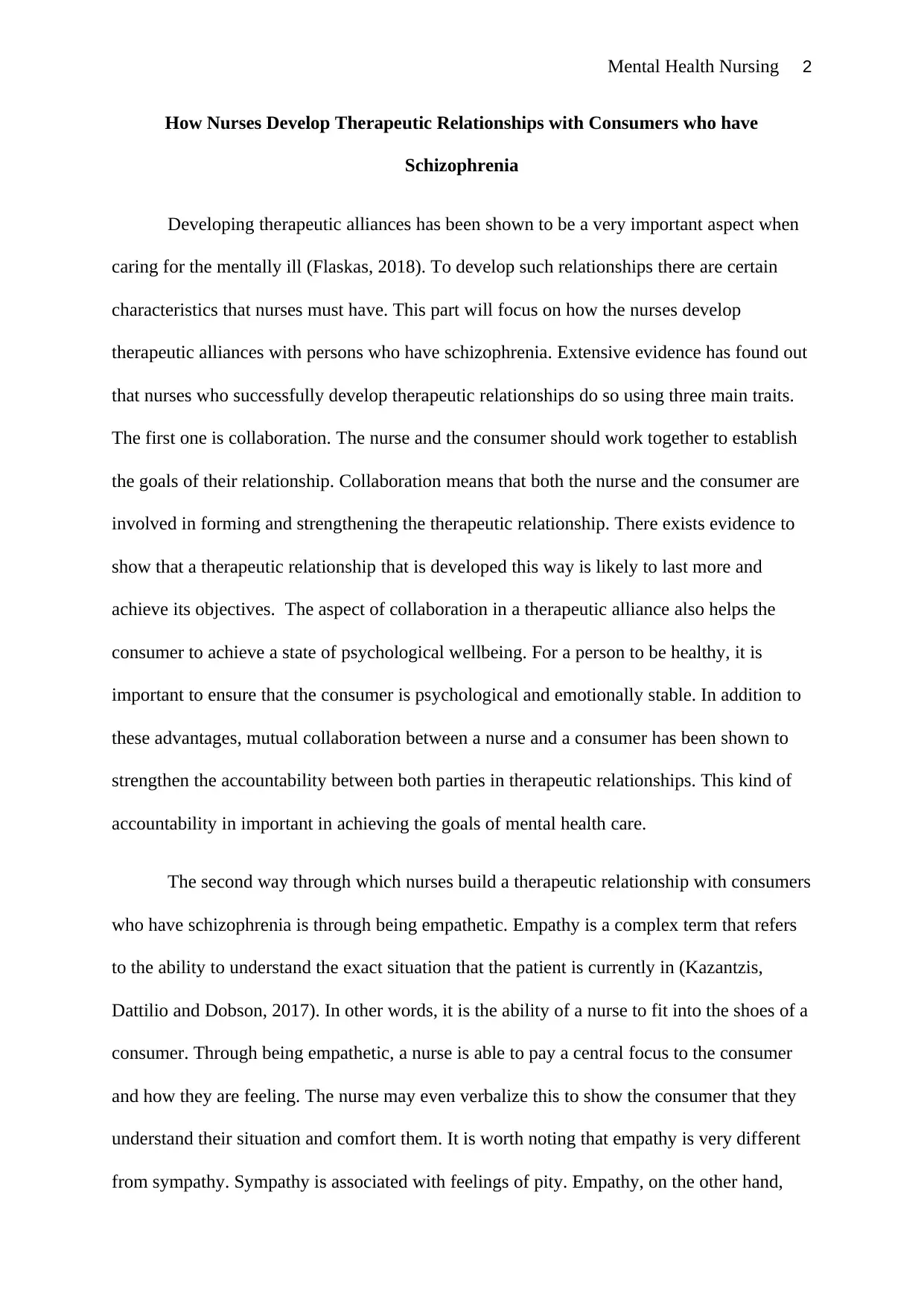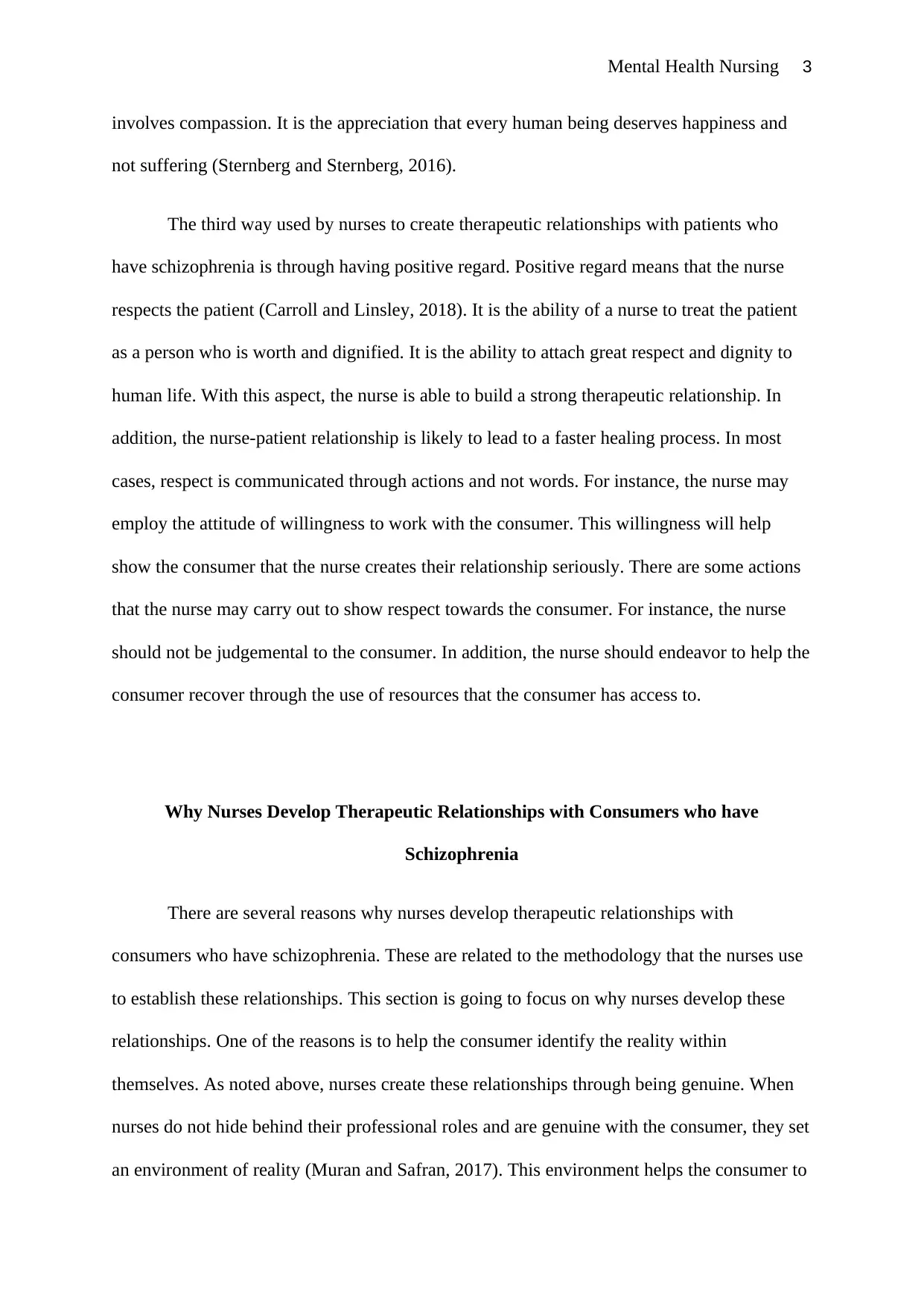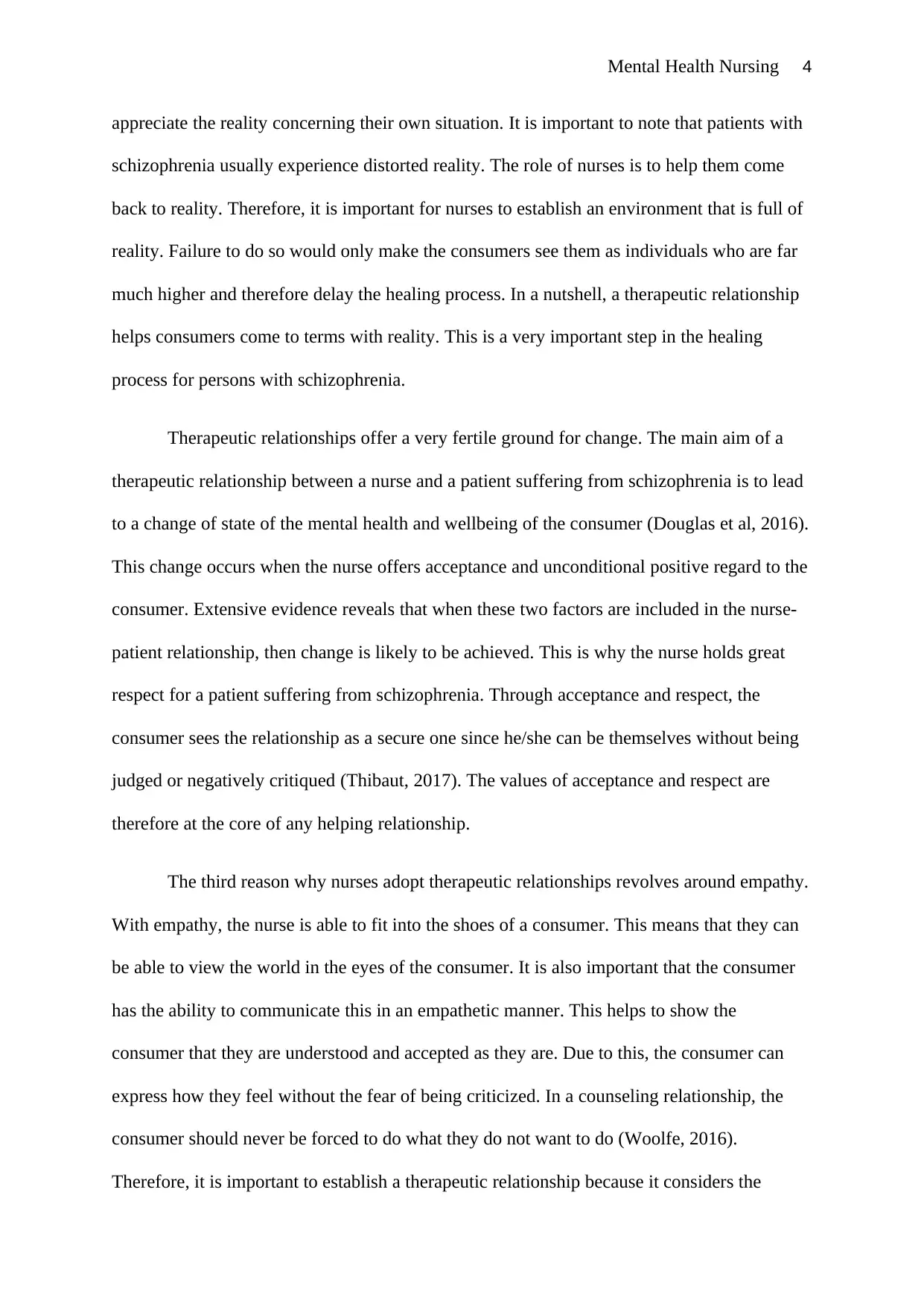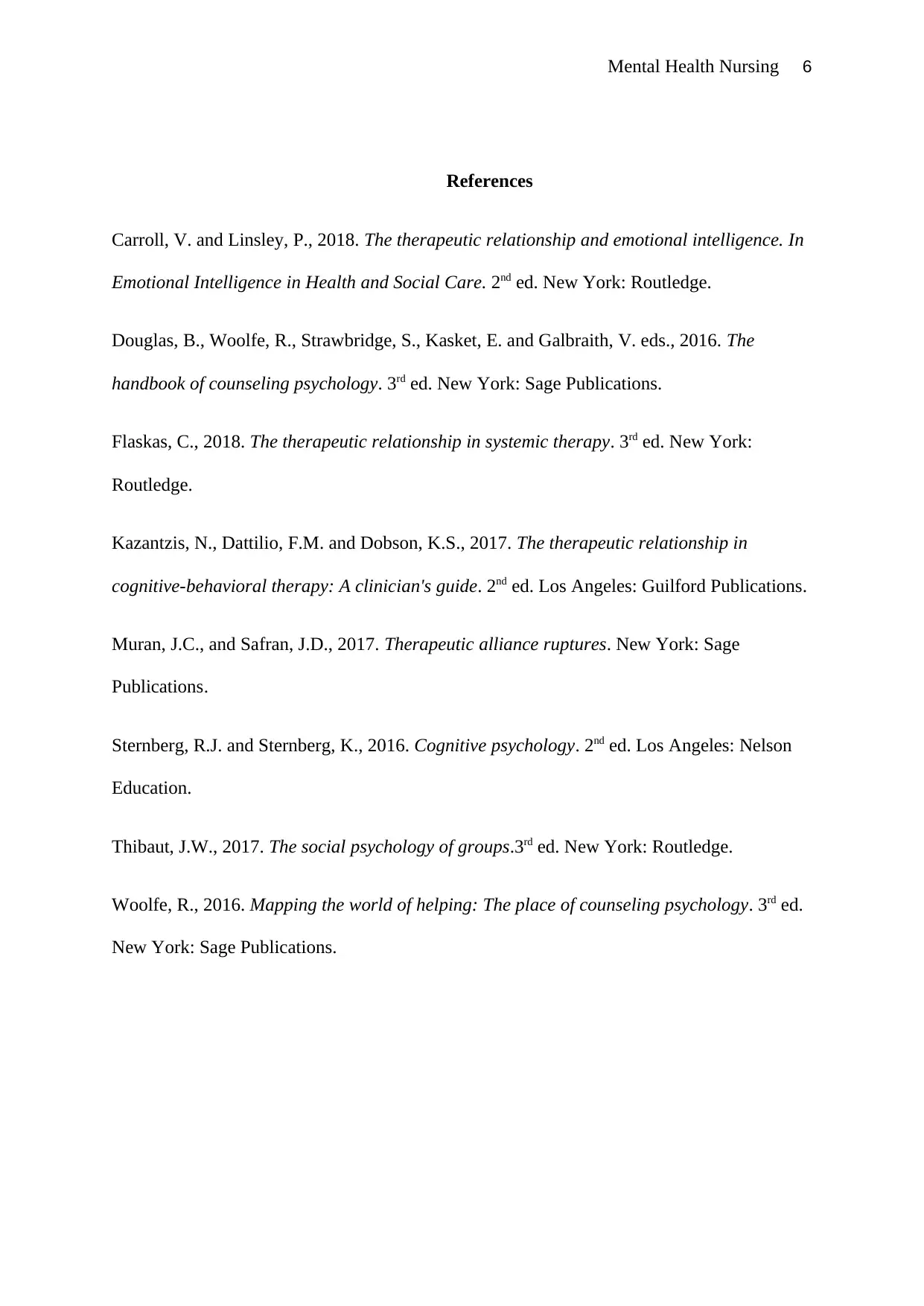How Nurses Develop Therapeutic Relationships in Mental Health
VerifiedAdded on 2023/01/16
|6
|1406
|87
Essay
AI Summary
This essay delves into the critical role of therapeutic relationships in mental health nursing, specifically focusing on interactions with individuals diagnosed with schizophrenia. The assignment examines the 'how' and 'why' of these relationships, highlighting the significance of collaboration, empathy, and positive regard. It discusses how nurses establish these alliances by fostering genuine connections, promoting reality, and encouraging personal growth. The essay emphasizes that therapeutic relationships provide a foundation for change and improved mental health outcomes. The document references nursing and mental health literature to support its arguments, offering a comprehensive understanding of the topic.

Mental Health Nursing 1
Mental Health Nursing
By (Student’s Name)
Name of the course
Instructor’s Name
Institutional Affiliation
Department
Date
Mental Health Nursing
By (Student’s Name)
Name of the course
Instructor’s Name
Institutional Affiliation
Department
Date
Paraphrase This Document
Need a fresh take? Get an instant paraphrase of this document with our AI Paraphraser

Mental Health Nursing 2
How Nurses Develop Therapeutic Relationships with Consumers who have
Schizophrenia
Developing therapeutic alliances has been shown to be a very important aspect when
caring for the mentally ill (Flaskas, 2018). To develop such relationships there are certain
characteristics that nurses must have. This part will focus on how the nurses develop
therapeutic alliances with persons who have schizophrenia. Extensive evidence has found out
that nurses who successfully develop therapeutic relationships do so using three main traits.
The first one is collaboration. The nurse and the consumer should work together to establish
the goals of their relationship. Collaboration means that both the nurse and the consumer are
involved in forming and strengthening the therapeutic relationship. There exists evidence to
show that a therapeutic relationship that is developed this way is likely to last more and
achieve its objectives. The aspect of collaboration in a therapeutic alliance also helps the
consumer to achieve a state of psychological wellbeing. For a person to be healthy, it is
important to ensure that the consumer is psychological and emotionally stable. In addition to
these advantages, mutual collaboration between a nurse and a consumer has been shown to
strengthen the accountability between both parties in therapeutic relationships. This kind of
accountability in important in achieving the goals of mental health care.
The second way through which nurses build a therapeutic relationship with consumers
who have schizophrenia is through being empathetic. Empathy is a complex term that refers
to the ability to understand the exact situation that the patient is currently in (Kazantzis,
Dattilio and Dobson, 2017). In other words, it is the ability of a nurse to fit into the shoes of a
consumer. Through being empathetic, a nurse is able to pay a central focus to the consumer
and how they are feeling. The nurse may even verbalize this to show the consumer that they
understand their situation and comfort them. It is worth noting that empathy is very different
from sympathy. Sympathy is associated with feelings of pity. Empathy, on the other hand,
How Nurses Develop Therapeutic Relationships with Consumers who have
Schizophrenia
Developing therapeutic alliances has been shown to be a very important aspect when
caring for the mentally ill (Flaskas, 2018). To develop such relationships there are certain
characteristics that nurses must have. This part will focus on how the nurses develop
therapeutic alliances with persons who have schizophrenia. Extensive evidence has found out
that nurses who successfully develop therapeutic relationships do so using three main traits.
The first one is collaboration. The nurse and the consumer should work together to establish
the goals of their relationship. Collaboration means that both the nurse and the consumer are
involved in forming and strengthening the therapeutic relationship. There exists evidence to
show that a therapeutic relationship that is developed this way is likely to last more and
achieve its objectives. The aspect of collaboration in a therapeutic alliance also helps the
consumer to achieve a state of psychological wellbeing. For a person to be healthy, it is
important to ensure that the consumer is psychological and emotionally stable. In addition to
these advantages, mutual collaboration between a nurse and a consumer has been shown to
strengthen the accountability between both parties in therapeutic relationships. This kind of
accountability in important in achieving the goals of mental health care.
The second way through which nurses build a therapeutic relationship with consumers
who have schizophrenia is through being empathetic. Empathy is a complex term that refers
to the ability to understand the exact situation that the patient is currently in (Kazantzis,
Dattilio and Dobson, 2017). In other words, it is the ability of a nurse to fit into the shoes of a
consumer. Through being empathetic, a nurse is able to pay a central focus to the consumer
and how they are feeling. The nurse may even verbalize this to show the consumer that they
understand their situation and comfort them. It is worth noting that empathy is very different
from sympathy. Sympathy is associated with feelings of pity. Empathy, on the other hand,

Mental Health Nursing 3
involves compassion. It is the appreciation that every human being deserves happiness and
not suffering (Sternberg and Sternberg, 2016).
The third way used by nurses to create therapeutic relationships with patients who
have schizophrenia is through having positive regard. Positive regard means that the nurse
respects the patient (Carroll and Linsley, 2018). It is the ability of a nurse to treat the patient
as a person who is worth and dignified. It is the ability to attach great respect and dignity to
human life. With this aspect, the nurse is able to build a strong therapeutic relationship. In
addition, the nurse-patient relationship is likely to lead to a faster healing process. In most
cases, respect is communicated through actions and not words. For instance, the nurse may
employ the attitude of willingness to work with the consumer. This willingness will help
show the consumer that the nurse creates their relationship seriously. There are some actions
that the nurse may carry out to show respect towards the consumer. For instance, the nurse
should not be judgemental to the consumer. In addition, the nurse should endeavor to help the
consumer recover through the use of resources that the consumer has access to.
Why Nurses Develop Therapeutic Relationships with Consumers who have
Schizophrenia
There are several reasons why nurses develop therapeutic relationships with
consumers who have schizophrenia. These are related to the methodology that the nurses use
to establish these relationships. This section is going to focus on why nurses develop these
relationships. One of the reasons is to help the consumer identify the reality within
themselves. As noted above, nurses create these relationships through being genuine. When
nurses do not hide behind their professional roles and are genuine with the consumer, they set
an environment of reality (Muran and Safran, 2017). This environment helps the consumer to
involves compassion. It is the appreciation that every human being deserves happiness and
not suffering (Sternberg and Sternberg, 2016).
The third way used by nurses to create therapeutic relationships with patients who
have schizophrenia is through having positive regard. Positive regard means that the nurse
respects the patient (Carroll and Linsley, 2018). It is the ability of a nurse to treat the patient
as a person who is worth and dignified. It is the ability to attach great respect and dignity to
human life. With this aspect, the nurse is able to build a strong therapeutic relationship. In
addition, the nurse-patient relationship is likely to lead to a faster healing process. In most
cases, respect is communicated through actions and not words. For instance, the nurse may
employ the attitude of willingness to work with the consumer. This willingness will help
show the consumer that the nurse creates their relationship seriously. There are some actions
that the nurse may carry out to show respect towards the consumer. For instance, the nurse
should not be judgemental to the consumer. In addition, the nurse should endeavor to help the
consumer recover through the use of resources that the consumer has access to.
Why Nurses Develop Therapeutic Relationships with Consumers who have
Schizophrenia
There are several reasons why nurses develop therapeutic relationships with
consumers who have schizophrenia. These are related to the methodology that the nurses use
to establish these relationships. This section is going to focus on why nurses develop these
relationships. One of the reasons is to help the consumer identify the reality within
themselves. As noted above, nurses create these relationships through being genuine. When
nurses do not hide behind their professional roles and are genuine with the consumer, they set
an environment of reality (Muran and Safran, 2017). This environment helps the consumer to
⊘ This is a preview!⊘
Do you want full access?
Subscribe today to unlock all pages.

Trusted by 1+ million students worldwide

Mental Health Nursing 4
appreciate the reality concerning their own situation. It is important to note that patients with
schizophrenia usually experience distorted reality. The role of nurses is to help them come
back to reality. Therefore, it is important for nurses to establish an environment that is full of
reality. Failure to do so would only make the consumers see them as individuals who are far
much higher and therefore delay the healing process. In a nutshell, a therapeutic relationship
helps consumers come to terms with reality. This is a very important step in the healing
process for persons with schizophrenia.
Therapeutic relationships offer a very fertile ground for change. The main aim of a
therapeutic relationship between a nurse and a patient suffering from schizophrenia is to lead
to a change of state of the mental health and wellbeing of the consumer (Douglas et al, 2016).
This change occurs when the nurse offers acceptance and unconditional positive regard to the
consumer. Extensive evidence reveals that when these two factors are included in the nurse-
patient relationship, then change is likely to be achieved. This is why the nurse holds great
respect for a patient suffering from schizophrenia. Through acceptance and respect, the
consumer sees the relationship as a secure one since he/she can be themselves without being
judged or negatively critiqued (Thibaut, 2017). The values of acceptance and respect are
therefore at the core of any helping relationship.
The third reason why nurses adopt therapeutic relationships revolves around empathy.
With empathy, the nurse is able to fit into the shoes of a consumer. This means that they can
be able to view the world in the eyes of the consumer. It is also important that the consumer
has the ability to communicate this in an empathetic manner. This helps to show the
consumer that they are understood and accepted as they are. Due to this, the consumer can
express how they feel without the fear of being criticized. In a counseling relationship, the
consumer should never be forced to do what they do not want to do (Woolfe, 2016).
Therefore, it is important to establish a therapeutic relationship because it considers the
appreciate the reality concerning their own situation. It is important to note that patients with
schizophrenia usually experience distorted reality. The role of nurses is to help them come
back to reality. Therefore, it is important for nurses to establish an environment that is full of
reality. Failure to do so would only make the consumers see them as individuals who are far
much higher and therefore delay the healing process. In a nutshell, a therapeutic relationship
helps consumers come to terms with reality. This is a very important step in the healing
process for persons with schizophrenia.
Therapeutic relationships offer a very fertile ground for change. The main aim of a
therapeutic relationship between a nurse and a patient suffering from schizophrenia is to lead
to a change of state of the mental health and wellbeing of the consumer (Douglas et al, 2016).
This change occurs when the nurse offers acceptance and unconditional positive regard to the
consumer. Extensive evidence reveals that when these two factors are included in the nurse-
patient relationship, then change is likely to be achieved. This is why the nurse holds great
respect for a patient suffering from schizophrenia. Through acceptance and respect, the
consumer sees the relationship as a secure one since he/she can be themselves without being
judged or negatively critiqued (Thibaut, 2017). The values of acceptance and respect are
therefore at the core of any helping relationship.
The third reason why nurses adopt therapeutic relationships revolves around empathy.
With empathy, the nurse is able to fit into the shoes of a consumer. This means that they can
be able to view the world in the eyes of the consumer. It is also important that the consumer
has the ability to communicate this in an empathetic manner. This helps to show the
consumer that they are understood and accepted as they are. Due to this, the consumer can
express how they feel without the fear of being criticized. In a counseling relationship, the
consumer should never be forced to do what they do not want to do (Woolfe, 2016).
Therefore, it is important to establish a therapeutic relationship because it considers the
Paraphrase This Document
Need a fresh take? Get an instant paraphrase of this document with our AI Paraphraser

Mental Health Nursing 5
preferences of the consumer. There exists evidence to show that this type of relationship
helps the consumer to discover themselves and use the relationship for personal growth and
change.
preferences of the consumer. There exists evidence to show that this type of relationship
helps the consumer to discover themselves and use the relationship for personal growth and
change.

Mental Health Nursing 6
References
Carroll, V. and Linsley, P., 2018. The therapeutic relationship and emotional intelligence. In
Emotional Intelligence in Health and Social Care. 2nd ed. New York: Routledge.
Douglas, B., Woolfe, R., Strawbridge, S., Kasket, E. and Galbraith, V. eds., 2016. The
handbook of counseling psychology. 3rd ed. New York: Sage Publications.
Flaskas, C., 2018. The therapeutic relationship in systemic therapy. 3rd ed. New York:
Routledge.
Kazantzis, N., Dattilio, F.M. and Dobson, K.S., 2017. The therapeutic relationship in
cognitive-behavioral therapy: A clinician's guide. 2nd ed. Los Angeles: Guilford Publications.
Muran, J.C., and Safran, J.D., 2017. Therapeutic alliance ruptures. New York: Sage
Publications.
Sternberg, R.J. and Sternberg, K., 2016. Cognitive psychology. 2nd ed. Los Angeles: Nelson
Education.
Thibaut, J.W., 2017. The social psychology of groups.3rd ed. New York: Routledge.
Woolfe, R., 2016. Mapping the world of helping: The place of counseling psychology. 3rd ed.
New York: Sage Publications.
References
Carroll, V. and Linsley, P., 2018. The therapeutic relationship and emotional intelligence. In
Emotional Intelligence in Health and Social Care. 2nd ed. New York: Routledge.
Douglas, B., Woolfe, R., Strawbridge, S., Kasket, E. and Galbraith, V. eds., 2016. The
handbook of counseling psychology. 3rd ed. New York: Sage Publications.
Flaskas, C., 2018. The therapeutic relationship in systemic therapy. 3rd ed. New York:
Routledge.
Kazantzis, N., Dattilio, F.M. and Dobson, K.S., 2017. The therapeutic relationship in
cognitive-behavioral therapy: A clinician's guide. 2nd ed. Los Angeles: Guilford Publications.
Muran, J.C., and Safran, J.D., 2017. Therapeutic alliance ruptures. New York: Sage
Publications.
Sternberg, R.J. and Sternberg, K., 2016. Cognitive psychology. 2nd ed. Los Angeles: Nelson
Education.
Thibaut, J.W., 2017. The social psychology of groups.3rd ed. New York: Routledge.
Woolfe, R., 2016. Mapping the world of helping: The place of counseling psychology. 3rd ed.
New York: Sage Publications.
⊘ This is a preview!⊘
Do you want full access?
Subscribe today to unlock all pages.

Trusted by 1+ million students worldwide
1 out of 6
Related Documents
Your All-in-One AI-Powered Toolkit for Academic Success.
+13062052269
info@desklib.com
Available 24*7 on WhatsApp / Email
![[object Object]](/_next/static/media/star-bottom.7253800d.svg)
Unlock your academic potential
Copyright © 2020–2025 A2Z Services. All Rights Reserved. Developed and managed by ZUCOL.





